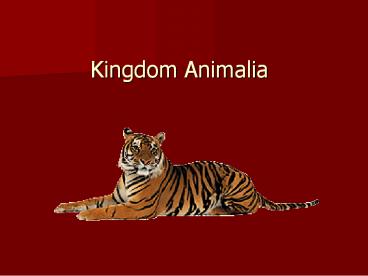Kingdom Animalia - PowerPoint PPT Presentation
1 / 21
Title:
Kingdom Animalia
Description:
Kingdom Animalia Characteristics Multicellular Eukaryotic with no cell walls Heterotrophs (consumers) Have a nervous system to respond to their environment ... – PowerPoint PPT presentation
Number of Views:344
Avg rating:3.0/5.0
Title: Kingdom Animalia
1
Kingdom Animalia
2
Characteristics
- Multicellular
- Eukaryotic with no cell walls
- Heterotrophs (consumers)
- Have a nervous system to respond to their
environment - Locomotion relates to ability to obtain food
3
Protection and Support
- Though not all animals have a skeleton, those
that do can be divided into two groups - Those with an exoskeleton a hard, waxy coating
on the outside of the body that protects internal
organs, provides a framework for support, and a
place for muscle attachment. - Those with an endoskeleton support framework
within the body that protects some organs and a
brace for muscles to pull against.
4
In the Animal Kingdom there are 9 Phyla
- Porifera
- Cnidaria
- Platyhelminthes
- Nematoda
- Annelida
- Mollusca
- Echinoderm
- Arthropoda
- Chordate
5
Phylum Porifera
- Sponges
- simplest form of animal life
- live in water
- Do not move around
- no symmetry
- Pores (holes) all over body
- Examples Tube Sponge, Glass Sponge, Sea Sponge
6
Phylum Cnidaria or Coelenterata
- Live in water
- Most have tentacles
- catch food with stinging cells
- Examples - Jellyfish, Hydra, sea anemones, and
corals
7
Phylum Platyhelminthes
- Flatworms
- Flat, ribbon-like body
- Live in water or are parasites
- bilateral symmetry
- Examples Planaria
- eyespots detect light
- food and waste go in and
out the same opening
8
Phylum Nematoda
- Roundworms
- Round, tubular body
- small or microscopic
- bilateral symmetry
- have both a mouth and anus
- Live in water or are parasites
- Examples
- Hookworm
- Trichinella
9
Phylum Mollusca
- Soft bodies
- Hard Shells
- Live on land or in water
- Important food source for humans
- Phylum Mollusca has three classes
10
Phylum Mollusca
- Class Gastropoda
- Or Univalves
- snails and slugs
- may have 1 shell
- stomach-footed - move on stomach
11
Phylum Mollusca
- Class Bivalves
- 2 shells hinged together
- clams, oysters,
- scallops and mussels
12
Phylum Mollusca
- Class Cephalopods
- squids and octopuses
- internal mantel
13
Phylum Annelida
- Segemented worms
- Body divided into segments(sections)
- Live in water or underground
- have a nervous and circulatory system
- eat soil and breakdown organic matter, wastes
provide nutrients to soil
14
Phylum Echinodermata
- Hard, spiny skin
- Live in salt water
- Radial symmetry
- name means spiney skinned
- endoskeleton
- Examples seastar, sea urchin, sand dollar and
sea cucumber
15
Phylum Arthropoda
- Body divided into sections/segments
- Exoskeleton
- Jointed legs
- well developed nervous system
- largest group of organisms on earth
- Phylum Arthropoda has 5 classes
16
Phylum Arthropoda
- Class Arachnida
- no antennae
- 4 pairs of legs
- 2 body regions - cephalothorax abdomen
- spiders, scorpions, mites ticks
17
Phylum Arthropoda Class Crustacea
- Shrimp, lobsters, crabs,
- barnacles, isopods
- 5 pairs of legs
18
Invertebrate Phylum Arthropoda
- Class Insecta
- no antennae
- 3 pairs of legs
- grasshoppers, ants, butterflies, bees
19
Phylum Arthropoda
- Class Diplopoda
- Millipedes
- segmented animals
- Have 2 pairs of legs per segment
20
Phylum Arthropoda
- Class Chilopods
- Centipede
- Segemented animals
- Have 1 pair of legs per body segment
21
Phylum Chordata
- 5 classes
- Fish
- Mammals
- Reptiles
- Amphibians
- Birds































